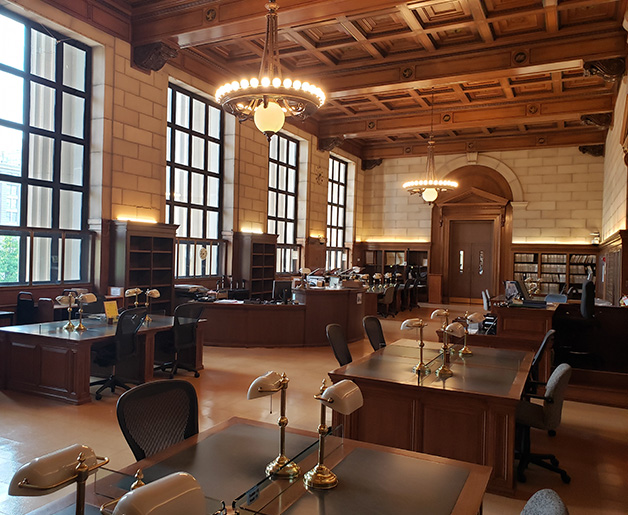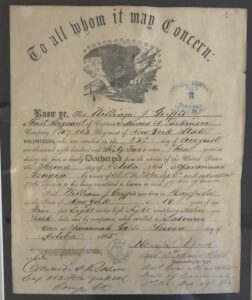While I often wondered where various branches of my family were from, pondered who a given individual was, my attention to family research did not start until I was drawn to a piece of paper that my father had placed into a simple frame.
The piece of paper was the Civil War discharge paper of my great-great-grandfather William Griffis. (Click on image to the right to see larger view.) My father had the one page discharge document in a simple wooden frame. He had the frame prominently displayed over the fireplace mantle along with William’s civil war musket. The musket still functions mechanically and has the ramrod and bayonet.
None of my living relatives knew anything about William Griffis. One of his sons, Charles Arthur Griffis, died when my grandfather was in his twenties. While details of William and Charles may have been known by my grandfather Harold Griffis, the stories and historical detail of William’s life dissolved in our family’s collective memory. My father’s generation and my generation knew little of William.
After completing college, starting a family and working, I came back to this simple framed document one day while visiting my parents and decided it needed to be professionally framed. As a gift to my father, I got the document framed to ensure its preservation. It was then that I started to think about what actually was contained on this one piece of paper.
The document contained a wealth of information about William and provided a starting point to isolate additional information about his life and family. William J. Griffis enlisted in the Union infantry at the age of 16. After three years and a little over a month of Civil War duty he was discharged in Savannah, Georgia as a First Sergeant at the age of 19. He was an infantryman of Company ‘A’ of the 153rd Regiment of the New York State volunteers. There is an October 16, 1865 stamp for bounty paid and a June 28, 1866 stamp for an additional bounty of $10.00.
The discharge paper also states that William was born in Mayfield, New York. He was five foot eight inches tall of light complexion with blue eyes and dark hair. He was a laborer when he enrolled in the service.
This whetted my appetite for more information and set the wheels in motion. This one piece of paper provided an initial glimpse of William James Griffis as a person. I knew where he was born. It gave me an approximate birth date. It gave me a glimpse of what he did for a living. It gave hints of his experience in the Civil War. The discharge paper provided an open door for future research on William and his family.
In the early 1990’s, many of the records now conveniently found on the internet were still not scanned and catalogued by many of the ancestry internet companies. You had to physically visit county, state and Federal buildings to access and view documents.
There are two moments that I vividly remember when I started to focus my efforts with family research that capture the thrill of doing historical research.
The first moment involved a trip to the Adirondack region of New York. I was in route to attend one of my cousin’s weddings in the summer. I decided to stop at Johnstown, the county seat of Fulton county where I knew William was born. Johnstown still has a small town feel with wide main streets and store front shops. I entered the county office and asked if they had historical records. With a smile the clerk said ‘step through the swing gate and follow me’. She led me to a room that had open windows that let the summer breeze into the room. She pointed to these huge racks that housed hard bound books three inches thick with two foot by three foot pages. These were the original New York census books. Each page contained handwritten lines that detailed how the census taker walked down country farm land streets and recorded each name in a household, their respective ages, and roles. In addition, a tally was made on how many pigs, cows, and horses might be on a given farm. At the beginning of each section for a town, it was noted what the weather was like for that particular year. Turning pages this large and then discovering a Griffis family was utterly amazing to me. I discovered William’s family when he was a child. I now had leads on who his father and siblings were. I also discovered a few pages later, which implied a few farm houses down the road for the census taker, an older Daniel Griffis and a William Griffis an age close to William’s father’s age, with other family members. I could only surmise in such a small town of Mayfield that these two households were related. I made copies of a few of these huge pages and took notes and left for the wedding. I thought it was amazing that these huge ledgers were merely residing in this back room in Johnstown, New York and anyone had access to them.
The second moment involved my visiting the National Archives. Based on my job, I was spending a lot of time working in our nation’s capital. Oftentimes I was taking the metro to the National Archive metro stop to attend meetings in office buildings in the area. It dawned on me that the National Archives housed the records of civil war veterans. So one day at lunch I went into the National Archives to locate William Griffis’ military and pension records. The main area of the archives is cavernous, a secular version of a church. Everyone is quiet, speaking in hushed tones and viewing documents. Sunlight is coming in through high windows and casting light on card file cabinets and desks. Sounds echoed in the main area.
I looked up William’s pension record numbers and wrote the information down on a record request form and presented it to a records clerk. I was told to come back the next day to view the files. The next day I came in and presented my request document. The clerk left and then came back with a brown envelope that contained a folder that was more than an inch thick, with legal sized papers along with smaller sized files. The folder had William Griffis’ name on it. This folder has been sitting in the archives for over a 100 years. I sat at an examining table and went through and turned each of the pages of original documents. There were military pay records, written affidavits by William and his wife (after he passed away) on issues regarding requests for pension assistance. There were medical examinations to prove disability. I held and read hand written letters from William on his military experiences. Words were often spelled phonetically in the letters, reflecting the few years of education he had growing up in Mayfield, New York. I was beginning to ‘see’ or envision a person reflected in these pages. I was just awestruck by the amount information I had access to as well as the fact that all of these documents have been preserved. I ended up getting his file copied. On subsequent trips I was able to obtain pension files for other relatives who served in the civil war, the war of 1812 and the revolutionary war.

Today, many of these records have been digitalized and accessible through commercial companies that provide subscriptions to access records through the internet. In some ways it is easier to access information. In other ways, the visceral experience of unearthing these documents in their element is missing. The process of discovery is the same whether you find new information on the internet or by unearthing a file or physical record. But the vividness of physical place and time, the tactile nature of touching old documents … that is something different.
In subsequent stories I will provide information from his military pension records that I was able to review at the National Archives and information gleaned from various U.S. and New York state census.
For more information on the Civil War musket, see this page.



Your story captures my interest. It’s an invitation to embark on an adventure! So looking forward to future posts and traveling with you.